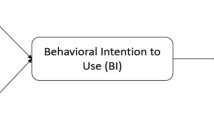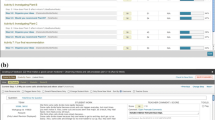Abstract
This paper examines variability in teachers’ usage patterns as they interacted with an online teacher support tool, the Curriculum Customization Service (CCS), in their professional work. Understanding variation of use with technology provides information about why users, and in this case teachers, use certain elements in their planning and teaching. By mining the usage log files of over 40 teachers who used the CCS over a year-long period, we analyzed for variability using a framework developed in marketing research to characterize appropriation of technology. This analysis helped reveal different kinds of teachers’ patterns along two dimensions: frequency and variability of use. We then turned to qualitative records of teachers’ experiences during the year to better understand why those variations appeared. Focusing on the experiences of several teachers, using their log files with interview and observation data, we distilled “contextual contingencies” that influenced how they chose to use the CCS.



Similar content being viewed by others
References
Aubusson, P., Burke, P., Schuck, S., Kearney, M., & Frischknecht, B. (2014). Teachers choosing rich tasks: The moderating impact of technology on student learning, enjoyment, and preparation. Educational Researcher, 43(5), 219–229.
Baker, R. S. J. D., & Yacef, K. (2009). The state of educational data mining in 2009: A review and future visions. Journal of Educational Datamining, 1(1), 3–17.
Bielaczyc, K., & Collins, A. (2006). Implementation paths: Supporting the trajectory teachers traverse in implementing technology-based learning environments in classroom practice. Educational Technology, 46(3), 8–14.
Bienkowski, M., Feng, M., & Means, B. (2012). Enhancing teaching and learning through educational data mining and learning analytics: An issue brief. Washington, DC: Office of Educational Technology, US Department of Education, 1–57.
Bowker, G., Star, S. L., Turner, W., & Gasser, L. (Eds.). (1997). Social science, technical systems and cooperative work: Beyond the great divide. Hillsdale: Erlbaum.
Butcher, K., Ferrara, L., & Devaul, H. (2013). Teachers’ use of an online curriculum planning tool: Usage patterns associated with student learning. Proceedings of EdMedia 2013: World conference on Educational Media & Technology. Chesapeake, VA: AACE.
Clarke, D., & Hollingsworth, H. (2002). Elaborating a model of teacher professional growth. Teaching and Teacher Education, 18, 947–967.
Crossley, S., Paquette, L., Dascalu, M., McNamara, D. S., & Baker, R. (2016). Combining click-stream data with NLP tools to better understand MOOC completion in Proceedings of the Sixth International Conference on Learning Analytics & Knowledge (LAK '16). Association for Computing Machinery, New York, NY, 6–14. https://doi.org/10.1145/2883851.2883931.
Dede, C., Ketelhut, D. J., Whitehouse, P., Breit, L., & McCloskey, E. M. (2009). A research agenda for online teacher professional development. Journal of Teacher Education, 60(1), 8–19.
Ertmer, P. A., Ottenbreit-Leftwich, A. T., Sadik, O., Sendurur, E., & Sendurur, P. (2012). Teachers beliefs and technology integration practices: A critical relationship. Computers and Education, 59, 423–435.
Filvà, D. A., Forment, M. A., García-Peñalvo, F. J., Escudero, D. F., & Casañ, M. J. (2019). Clickstream for learning analytics to assess students’ behavior with scratch. Future Generation Computer Systems, 93, 673–686.
Fishman, B. J. (2003). Linking on-line video and curriculum to leverage community knowledge. Advances in research on teaching, 10, 201–234.
Hamilton, E. R., Rosenberg, J. M., & Akcaoglu, M. (2016). The substitution augmentation modification redefinition (SAMR) model: A critical review and suggestions for its use. TechTrends, 60, 433–441.
Hollan, J. D., Hutchins, E. L., & Kirsh, D. (2000). Distributed cognition: A new theoretical foundation for human-computer interaction research. ACM Transactions on computer-human interaction, 174-196.
Horn, I. S. (2005). Learning on the job: A situated account of teacher learning in high school mathematics departments. Cognition and Instruction, 23(2), 207–236.
Kimmons, R., Graham, C. R., & West, R. E. (2020). The PICRAT model for technology integration in teacher preparation. Contemporary Issues in Technology and Teacher Education, 20(1), 176–198.
Koehler, M., & Mishra, P. (2009). What is technological pedagogical content knowledge (TPACK)? Contemporary Issues in Technology and Teacher Education, 9(1), 60–70.
Kolb, S. M. (2012). Grounded theory and the constant comparative method: Valid research strategies for educators. Journal of Emerging Trends in Educational Research and Policy Studies, 3(1), 83–86.
Lee, V. R., Leary, H., Sellers, L., & Recker, M. (2014). The role of school district science coordinators in the district-wide appropriation of an online resource discovery and sharing tool for teachers. Journal of Science Education and Technology, 23(3), 309–323.
Li, Q., Baker, R., & Warschauer, M. (2020). Using clickstream data to measure, understand, and support self-regulated learning in online courses. The Internet and Higher Education, 45, 1–13.
Maull, K., Saldivar, M. G., & Sumner, T. (2011). Understanding digital library adoption: A use diffusion approach. In Proceedings of ACM/IEEE Joint Conference on Digital Libraries (pp. 121-130), ACM, New York.
McKenney, S., Kali, Y., Markauskaite, L., & Voogt, J. (2015). Teacher design knowledge for technology enhanced learning: An ecological framework for investigating assets and needs. Instructional Science, 43, 181–202.
Pennington, M. C. (2004). Cycles of innovation in the adoption of information technology: A view for language teaching. Computer Assisted Language Learning, 17(1), 7–33.
Putnam, R. T., & Borko, H. (2000). What do new views of knowledge and thinking have to say about research on teacher learning? Educational Researcher, 29(1), 4–15.
Recker, M., Yuan, M. & Ye, L. (2014). CrowdTeaching: Supporting teachers as designers in collective intelligence communities. The International Review of Research in Open and Distance Learning, 15(4), 138–160.
Renninger, K. A., & Shumar, W. (2002). Community building with and for teachers: The math forum as a resource for teacher professional development. In K. A. Renninger & W. Shumar (Eds.), Building virtual communities: Learning and change in cyberspace. New York, NY: Cambridge University Press.
Rogers, E. M. (2003). Diffusion of innovations (5th ed.). New York, NY: The Free Press.
Schlager, M. S., & Fusco, J. (2003). Teacher professional development, technology, and communities of practice: Are we putting the cart before the horse? The Information Society, 19(3), 203–220.
Schneider, R. M., Krajcik, J., & Blumenfeld, P. (2005). Enacting reform-based science materials: The range of teacher enactments in reform classrooms. Journal of Research in Science Teaching, 42(3), 283–312.
Shapiro, R. B., & Wardrip, P. S. (2011). Interactive representations of student activity to inform teacher collaborations: Results from a formative exploration. In Proceedings of CSCL2011 9th International Computer-Supported Collaborative Learning Conference (pp. 494-501).
Sherin, M., & van Es, E. (2005). Using video to support teachers’ ability to notice classroom interactions. Journal of Technology and Teacher Education, 13(3), 475–491.
Shih, C., & Venkatesh, A. (2004). Beyond adoption: Development and application of a use-diffusion model. The Journal of Marketing, 68(1), 59–72.
Suárez-Rodríguez, J., Almerich, G., Orellana, N., & Díaz-García, I. (2018). A basic model of integration of ICT by teachers: Competence and use. Educational Technology Research & Development, 66(5), 1165–1187.
Sumner, T. & CCS Team. (2010). Customizing science instruction with educational digital libraries. In Proceedings of the 10th ACM/IEEE-CS Joint Conference on Digital Libraries (JCDL 2010) (p. 4), New York: ACM.
Tondeur, J., van Braak, J., Ertmer, P. A., & Ottenbreit-Leftwich, A. (2017). Understanding the relationship between teachers’ pedagogical beliefs and technology use in education: A systematic review of qualitative evidence. Educational Technology Research & Development, 65(3), 555–575.
Xu, B., & Recker, M. (2012) Teaching analytics: A clustering and triangulation study of digital library user data. Educational Technology & Society Journal, 15(3), 10–3115.
Ye, L., Recker, M., Walker, A., Leary, H., & Yuan, M. (2015). Expanding approaches for understanding impact: Integrating technology, curriculum, and open educational resources in science education. Educational Technology Research and Development, 63(3), 355–380.
Acknowledgements
We thank the teachers (and their students) who participated in our study. This work could not have been conducted without their participation.
Funding
This work was supported by a grant from the National Science Foundation (DUE-1043858 and DUE-1043638). The opinions expressed herein are those of the authors and do not necessarily reflect those of the NSF. The authors declare they have no funding or conflict of interest in this work.
Author information
Authors and Affiliations
Corresponding author
Ethics declarations
Conflict of Interest
We have no conflicts of interest to disclose.
Research Involving Human Participants, their Data or Biological Material
Data collected for this work can be accessed by contacting the authors and will be shared as anonymized data. This work was conducted under the approval of the institutional review boards at the authors institutions at the time of data collection. Informed consent was obtained from all individual participants included in the study.
Additional information
Publisher’s Note
Springer Nature remains neutral with regard to jurisdictional claims in published maps and institutional affiliations.
Rights and permissions
About this article
Cite this article
Leary, H., Lee, V.R. & Recker, M. It’s More Than Just Technology Adoption: Understanding Variations in Teachers’ Use of an Online Planning Tool. TechTrends 65, 269–277 (2021). https://doi.org/10.1007/s11528-020-00576-3
Accepted:
Published:
Issue Date:
DOI: https://doi.org/10.1007/s11528-020-00576-3




